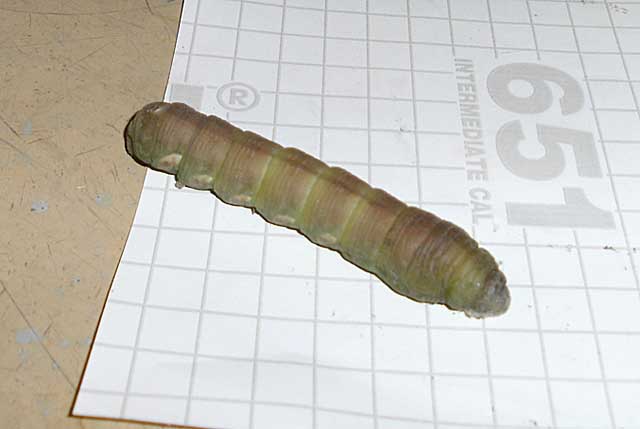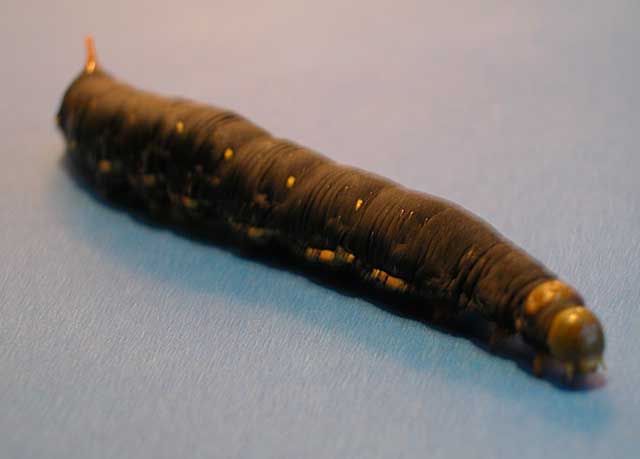Manitowoc County, Wisconsin
Sphingidae Larvae

Eumorpha pandorus prepupal larva, Manitowoc, Manitowoc County, Wisconsin,
August 22, 2010, courtesy of Janeen Koch.
|
|
Created/dedicated as per personal communication with Janeen Koch, Manitowoc, (Eumorpha pandorus larva), August 2010 Updated as per James P. Tuttle's The Hawk Moths of North America, August 2010 Updated as per personal communication with Janeen Koch, Manitowoc, (Hyles lineata larva), October 6, 2013 |

This page is inspired by and dedicated to Janeen Koch, who sent me the prepupal Eumorpha pandorus image, top of this page.
Janeen writes, "I was wondering if you could help me out with the attached pictures. I have tried finding a picture of this on the internet, but nothing I
saw looks like this. I live in Manitowoc, Wisconsin and I found this crawling across my workshop floor this morning. It is about 3-1/2" long. Years ago,
we found a Cecropia caterpillar and when it hatched in spring it was the most beautiful thing! So I would like to keep this one and see what it becomes,
but I don't want to kill it by doing the wrong thing to it. So far I just have it in a bucket with some leaves.
"Could you give me any more information as to what this is, and how I should care for it? I don't know if it's done eating and looking for a place to make
a cocoon or what.
"Thanks in advance for any help!"
"It is done feeding and is ready to pupate. In the wild, the caterpillar would excavate a subterranean chamber in which to pupate, but if you put it in a
sandwich sized gladware or tupperware type plastic tub with no air holes and lid on tight, it will pupate in there in 3-5 days under a folded piece of
paper towel you need to insert when you put the caterpillar inside.
"It will give off moisture and shrink a bit, and legs will get quite stumpy. This is all natural before pupation.
"I would like permission to post image, credited to you, to a Manitowoc County pictoral checklist that I will create."
"I am fascinated to find out it naturally pupates underground. I can't quite imagine how the moth gets out when ready."
"I see you are from PEI. I have never been there, but several years back we took a camping trip in New Brunswick and Nova Scotia. That is quite a long
drive from here, but it sure was beautiful.
"Thanks again for taking time to help, and for sharing your wealth of knowledge!"
I store my cocoons and pupae in the tubs I have mentioned above in the crisper compartment of my refrigerator. My wife has one compartment for lettuce and cucumbers, etc.,
and I have the other compartment for cocoons and pupae. i would not put the pupae into cold storage until mid to late October.
As long as the caterpillar has not been parasitized, you have an excellent chance of seeing an adult moth emerge.
Under natural conditions, the sweating and wiggling that the larvae does in its subterranean pupation chamber, acts to moisten and compact the soil and
almost "cement" it into a moderatly humid overwintering chamber. When the moth is ready to emerge, it will wiggle to the surface by telescoping its
abdominal segments inward, sticking the sharp point of its abdomen into the soil to block downward movement while it expands the abdominal segments to push
itself out of the chamber and upwards through the tunnel. It repeats these contractions and expansions until it reaches the surface where it will be able
to split open the pupal shell, emerge as a moth, and then climb, hang and inflate its wings by pumping fluid into its wing veins.
More info on storage and emergence container via article linked at top of page. Best of luck."
It is hoped that this checklist, with the thumbnails and notes, will help you quickly identify the larvae you have encountered.
A WO" after the species name indicates that I have no confirmed reports of this species in Manitowoc County, but I (William Oehlke) expect that this species is present.
Please help me develop this list with improved, documented accuracy by sending sightings (species, date, location), preferably with an image, via email to Bill Oehlke.
Please also send your sightings to BAMONA, an excellent online resource which has replaced USGS.
Many thanks to Janeen Koch who has provided another update with the following image of an almost entirely black Hyles lineata larva.

Hyles lineata, Manitowoc, Wisconsin,
October 6, 2013, courtesy of Janeen Koch.
Sphinginae subfamily
Smerinthini Tribe:
Macroglossinae subfamilyDilophonotini Tribe:
Philampelini Tribe:
Macroglossini Tribe:
|
Eggs of many North American species are offered during the spring and summer. Occasionally summer Actias luna and summer Antheraea polyphemus cocoons are available. Shipping to US destinations is done from with in the US.
Use your browser "Back" button to return to the previous page.
This page is brought to you by Bill Oehlke and the WLSS. Pages are on space rented from Bizland. If you would like to become a "Patron of the Sphingidae Site", contact Bill.
Please send sightings/images to Bill. I will do my best to respond to requests for identification help.
 Show appreciation for this site by clicking on flashing butterfly to the left. The link will take you to a page with links to many insect sites. |
I very much appreciate all the many images that have been sent to me, or of which I have been granted permission to copy and post from other websites. All images on this site remain the property of respective photographers.
If you would like to contribute to the maintenace of this website by sending a contribution to
Bill Oehlke
Box 476
155 Peardon Road
Montague, Prince Edward Island, C0A1R0
Canada
your donation would be much appreciated and would be used for
1) paying for webspace rental;
2) paying for computer maintenance and software upgrades;
3) purchases of additional text reference material (journals and books) in anticipation of expanding the site to a worldwide Sphingidae site;
4) helping to pay my daughter's tuition (completed spring of 2013); with anything left over going to humanitarian aid.
If you are mailing a check from USA, please use $1.10 (2013 rate) postage. Donations can also be made through Paypal via the button below.